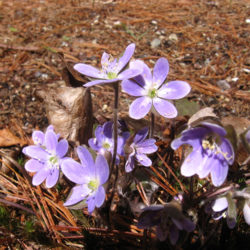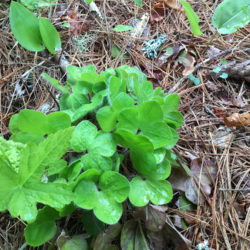Etymology
Anemone is Greek (anemos) for wind, and americana is Latin for North or South America. Its common name of hepatica is derived from a Greek word that means the liver; the 3-lobed leaf of this plant was thought to resemble a human liver.
Previously classified as Hepatica americana and similar to but distinguishable from sharp-toothed hepatica (Anemone acutiloba).
Native Habitat
Typically found in part shade, in mixed upland woods.
Garden Uses
Lovely naturalized in woodland gardens.
Overview
One of the first spring wildflowers, it tolerates drier and more acidic soils than sharp-toothed hepatica but prefers medium moisture and some winter snow cover.
Leaves and Stems
Simple, smooth-edged leaves appear after flowers, and are made up of three rounded lobes of similar size, approximately 3 by 3 inches total. Leaves grow from the base of the plant, on hairy, thin stems. Spring leaves are solid to two-tone green, turning to dark green or brown in autumn, and persisting through much of winter before they wither prior to spring flowering.
Flowers
Single flowers are 1/2 to 1 inch across, at the end of a hairy, leafless stalk, typically bearing 6 (range 5-12) petals in lavender to white around a green center with numerous white stamens. Flowers are radially symmetrical. Behind each flower are 3 large, green, hairy bracts (modified leaves or scales), each up to 1/2 inch long, oval, with blunt or rounded tips. One plant will display a clump of many flowers, blooming April to May.
Fruit/Seed
Fruit is dry, does not split open when ripe, and measures less than 1/4 inch (3.5 to 5 mm). May self-seed in optimum conditions.
Wildlife Associates
Flowers are attractive to pollinators.
Propagation
Sow fresh seed for germination the following spring. Propagated seedlings may take several years to flower, and plants may be slow to thicken sufficiently for division.
Ethnobotanical Uses
Early settlers made an herbal tea from the leaves to treat liver ailments.
Sources
Plant Profile by Kate O’Dell


